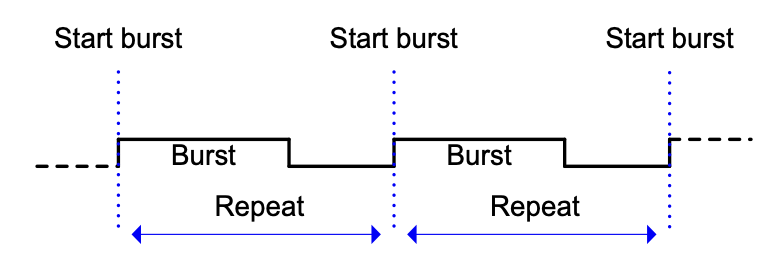6.7.4. Scheduler Functions
As described in Section Overview, Chimera supports automatically turning the impairments on and off with the configured distribution using a per impairment scheduler.
The scheduler is configured depending on the distribution type which is applied to the impairment. There are 2 types of distributions:
Continuous distributions
Burst distributions
Table 6.16 illustrates Bursty and Continuous distributions.
Continuous |
Bursty |
|---|---|
Random Burst |
Fixed burst |
Fixed Rate |
Accumulate & Burst |
Random Rate |
|
Bit Error Rate |
|
Gilbert-Elliot |
|
Uniform |
|
Gamma |
|
Gaussian |
|
Poisson |
|
Step |
|
Custom distribution |
Notice that for latency / jitter, only the Accumulate & Burst supports a scheduler. If other distributions are applied to latency / jitter, only continuous mode is supported.
Continuous Distributions
For continuous distributions, the scheduler can work in 2 modes:
Continuous: When started, the impairment is applied continuously with the configured distribution until it is manually stopped.
The example below illustrates how to configure the scheduler in continuous mode for drop with fixed rate distribution of 1.23%.
PED_SCHEDULE[fid,0] 1 0
PED_FIXED [fid,0] 12300
Repeat Pattern: When started, the impairment is applied with the configured distribution in a repeated pattern. First it will be applied for a configurable duration and then turned off. It will be restarted for every repeat period.
This is illustrated in Fig. 6.70.

Fig. 6.70 Scheduler function Repeat Pattern
The example below illustrates how to configure the scheduler for duration = 1.20 sec and a repeat period = 5.2 sec, applying drop with random rate distribution of 3.3421 %.
PED_SCHEDULE[fid,0] 1200 5200
PED_RANDOM [fid,0] 33421
Bursty Distributions
The bursty distributions are characterized by being bursty by nature, i.e. they will automatically terminate if not restarted. E.g., a fixed burst of 8 packets will automatically stop after dropping 8 packets.
For bursty distributions, the scheduler can work in 2 modes.
One-Shot: When started, the impairment will be applied for the duration of the burst. When the burst terminates, the impairment is turned off.
The example below illustrates how to configure the scheduler for in shot mode for drop with a fixed burst distribution of 10 packets.
PED_SCHEDULE [fid,0] 1 0
PED_FIXEDBURST[fid,0] 10
Repeat Burst: When started, the impairment will be applied for the duration of the burst. The burst will be restarted every Repeat period.
This is illustrated in Fig. 6.71.

Fig. 6.71 Scheduler function Repeat Burst.
The example below illustrates how to configure the scheduler to restart the Accumulate & Burst every 2.36 sec with a Burst Delay of 0.654 sec.
PED_SCHEDULE[fid,2] 1 2360
PED_ACCBURST[fid,2] 654000